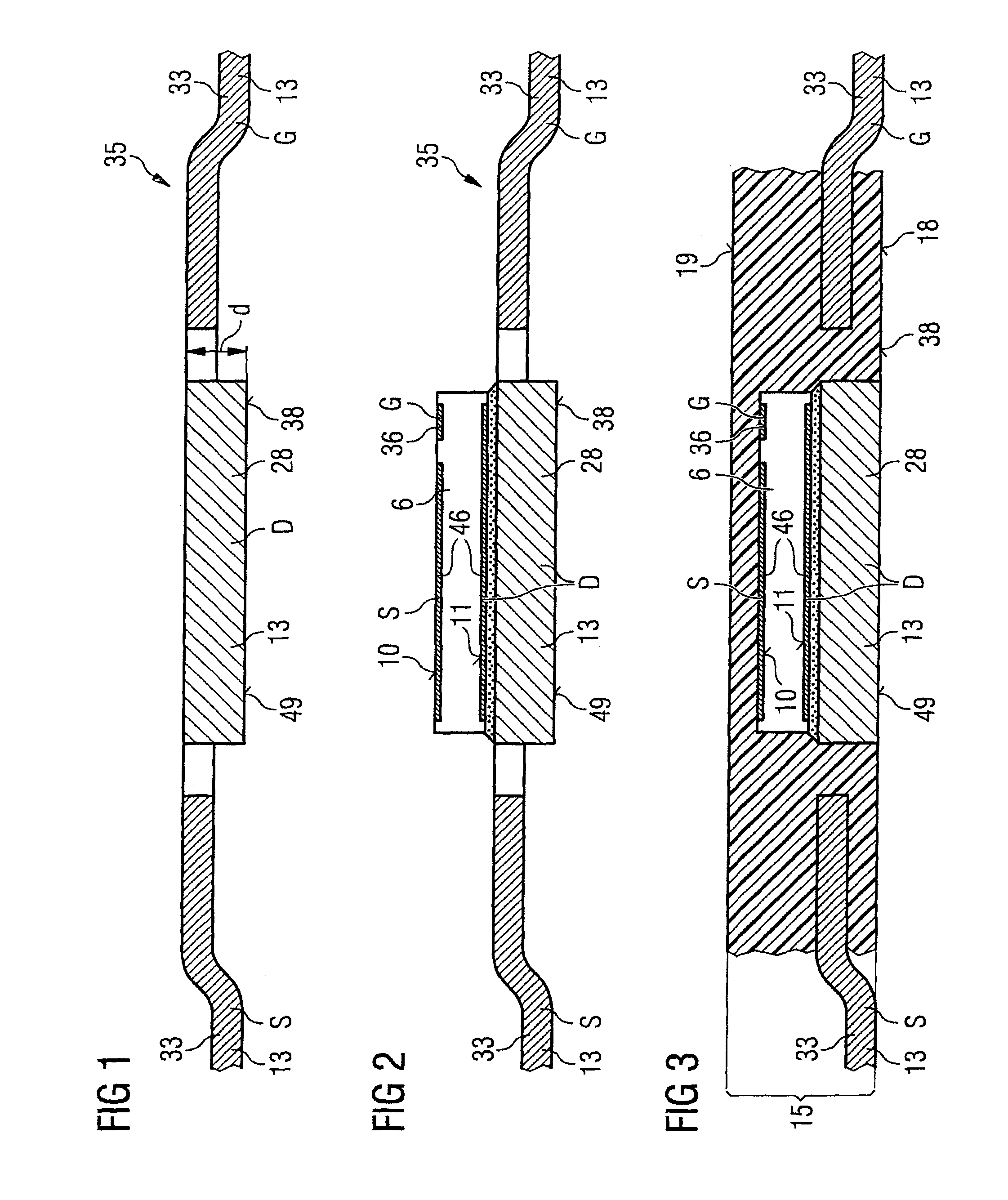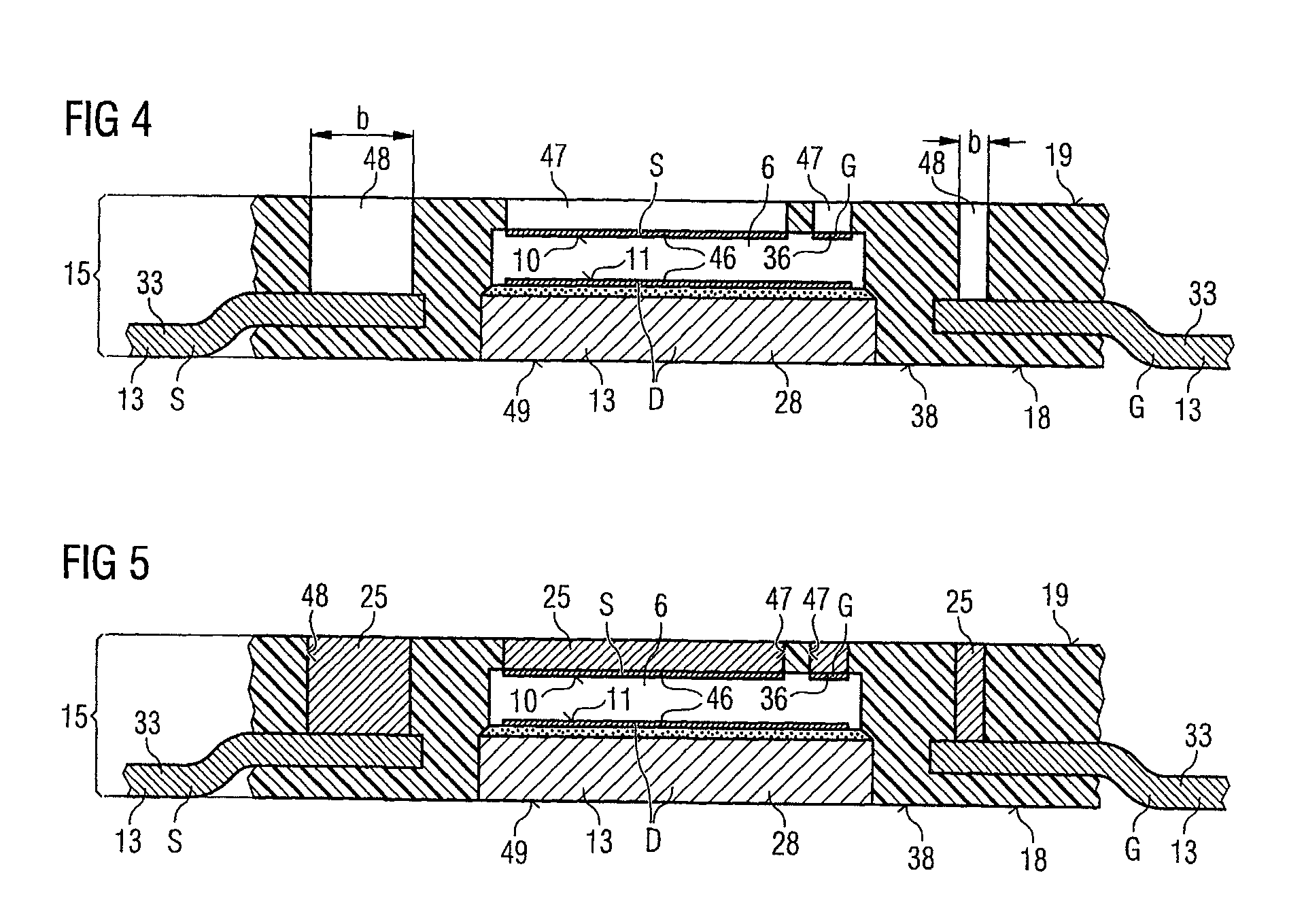Power semiconductor device and method for its production
- Summary
- Abstract
- Description
- Claims
- Application Information
AI Technical Summary
Benefits of technology
Problems solved by technology
Method used
Image
Examples
first embodiment
[0053] FIGS. 1 to 7 show schematic cross sections through components in the production of a power semiconductor device 1 according to the invention. Components with the same functions are identified in the subsequent figures by the same designations and are not explained more than once.
[0054]FIG. 1 shows a schematic cross section through a leadframe 35. Such leadframes 35 may, depending on the type of package, be differently patterned. There are leadframes which have in addition to a chip carrier 28, as is shown in FIG. 1, external leads 33, which are dimensioned in such a way that they provide external contact areas on the underside and / or on edge sides of a plastic package 14 after completion. Other leadframes 35 are intended to allow leads 33 to protrude as external contacts 13 from the plastic package of the power semiconductor device on the edge sides. In this embodiment of the invention, a leadframe 35 is used, having external contacts 13 which have the form of external leads ...
second embodiment
[0063] In the production of the second layer of plastic 16, it is mounted with its underside 20 on the first layer of plastic 15. With the plate regions 27 of the connecting elements 12 being formed with different thicknesses, it is also possible that the electrodes of the power semiconductor chip 6 can be accessed from the surface 32 of the power semiconductor device, which is formed by the upper side 21 of the second layer of plastic 16. This is shown in the invention.
[0064]FIG. 8 shows a schematic cross section through a power semiconductor device 2 according to a second embodiment of the invention. Components with the same functions as in the previous figures are identified by the same designations and are not explained in any more detail. The difference between the second embodiment of the invention according to FIG. 8 and the first embodiment of the invention according to FIG. 7 is that the plate regions 27 of the wiring elements 12 have different thicknesses S1 and S2. While ...
third embodiment
[0065]FIG. 9 shows a schematic cross section through a power semiconductor device 3 according to the invention. The difference from the previous embodiments of the invention is that the source electrode S of the power semiconductor chip 6 is connected to the chip carrier 28 in a first layer of plastic 15 by means of a plate region 27 of a connecting element 12 with contact vias 25. The power semiconductor chip 6 itself is arranged in a second layer of plastic 16 and is covered by a third layer of plastic 17.
[0066] Arranged in the third layer of plastic 17 is a further wiring layer 34, which has a further plate region 27 of a connecting element 12. The further plate region 27 of the connecting element 12 in the third layer of plastic 17 forms a connection between the drain electrode D on the back side 11 of the power semiconductor chip 6 and a lead 33 by means of a contact via 26 and a plate region 27 in the second layer of plastic 16 as well as by means of a further contact via 25. ...
PUM
 Login to View More
Login to View More Abstract
Description
Claims
Application Information
 Login to View More
Login to View More - R&D
- Intellectual Property
- Life Sciences
- Materials
- Tech Scout
- Unparalleled Data Quality
- Higher Quality Content
- 60% Fewer Hallucinations
Browse by: Latest US Patents, China's latest patents, Technical Efficacy Thesaurus, Application Domain, Technology Topic, Popular Technical Reports.
© 2025 PatSnap. All rights reserved.Legal|Privacy policy|Modern Slavery Act Transparency Statement|Sitemap|About US| Contact US: help@patsnap.com



